Featured Posts
Sports
Games
Thursday, April 9, 2015
The Difference Between Being Really Smart ... And Being A Genius
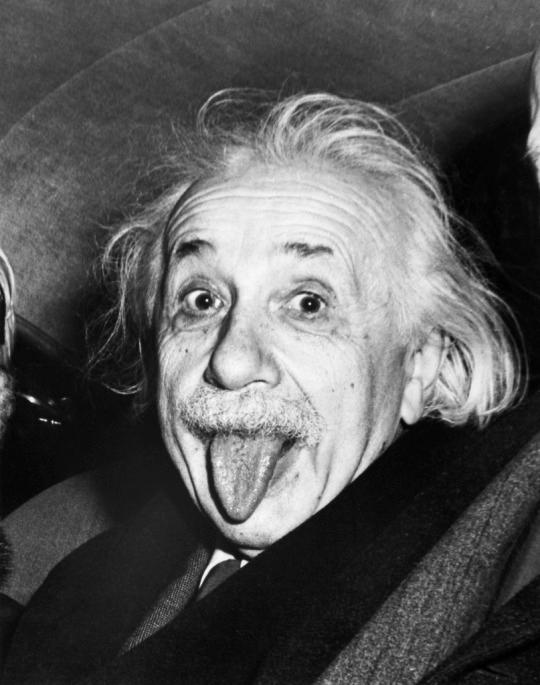
Most people tend to think of high IQ and genius as virtually the same, but they’re far from it. Albert Einstein’s estimated IQ is 160, but it was probably something else that gave him his special smartness sauce. Photo: Corbis/Arthur Sasse)
Einstein. Mozart. Socrates. Freud. Curie. Van Gogh. Newton. Locke. Jobs.
There’s intelligence, and then there’s genius. Everyone knows the famous names in history, of men and women who made game-changing contributions to their respective fields. But what is genius?
Earlier this week, Long Island high-school student Harold Ekeh earned acceptance into all eight Ivy League institutions, along with other respected universities like MIT and Johns Hopkins. He is, by all indications, a highly-intelligent young man. But will his name ever fall in alongside the greats?
Usually, we look at geniuses in retrospect, which makes cultivating and understanding genius a tall order. According to Richard Haier, Ph.D, a professor emeritus in the Pediatric Neurology Division of the School of Medicine at University of California, Irvine, the concept is not well understood.
“There are a lot of myths,” he tells Yahoo Health. “There’s a widespread belief that intelligence can be enhanced by enriching children’s lives early, but that has never been demonstrated by research. The research on genetic influences is stronger but how intelligence emerges as a child develops is not so clear, especially when we try to understand what genius is.”
This points to genetics, a major component in genius – but not the only one. Much of what we know to this point is blurry, yet developing and exciting. First, though, what is “genius” exactly?
More questions than answers
“There’s no one way to define genius,” Haier says. “For example, the high end of the IQ spectrum can be considered genius — say the top 0.1 percent of raw intelligence.”
But that’s more or less intellect. Many smart people don’t accomplish much. Genius, we recognize, is something else. Haier goes further: “Does it take doing something great in your field?” he says. “Was Steve Jobs a genius? He certainly created products and a company that have changed the world. I have no problem calling him a creative genius, but was he always the smartest guy in the room in terms of IQ?”
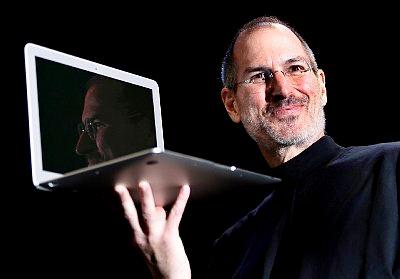
Steve Jobs had a higher than average intelligence, but experts question if his intelligence was highly superior. (Photo: Corbis)
We don’t have an IQ score for the visionary behind Apple, although Walter Issaccson alludes that he may have taken the test. Very few will argue that he wasn’t a genius, though, regardless of whatever score he may or may not have gotten.
But would Jobs have become a genius without a counterpart? “Wozniak actually did the engineering,” says Haier. “The two were completely different in terms of personality and motivation. But in terms of creative engineering, he is a genius too. We know his name because of Apple, but there are many other similar geniuses who have created important things we use everyday but we don’t know their names. What it illustrates is there are different routes for people who are exceptional and get the label of genius.”
When it comes to defining genius, it’s a complex equation. “Can you be extremely creative and have average intelligence?” Haier asks. “There seems to be a threshold of at least above average intelligence for creativity, but not in all fields. Musical ability, for instance, may be more independent of intelligence. It’s very muddied – but you don’t need a precise definition to do scientific research. Over time, research increases the precision of the definition.”
The brain of a genius: is it bigger, better?
There’s some debate about the genius brain, and whether or not it’s superior than a brain of average intelligence. Research hasn’t given us a definitive answer on that yet. Earl Hunt, Ph.D, a professor of psychology and adjunct professor of computer science at the University of Washington, has studied individual differences in intelligence, and says genius is something else.
“Genius is an extremely rare event,” Hunt tells Yahoo Health. “I don’t think, biologically, they are very different, or that there is a ‘genius brain’ component to giftedness. You can have very bright people. I’ve personally known five Nobel laureates, and they’re smarter than me, but I didn’t think they were qualitatively smarter.”

Wolfgang Amadeus Mozart is estimated to have an IQ of 165. But creative genius and intellect do not necessarily go hand in hand
Geniuses are certainly brilliant, though. So, if you peek inside the head of one of the best and brightest, is the brain any different than average? “It must be,” says Rex Jung, a neuroscientist, brain-imaging researcher and assistant professor of neurosurgery at the University of New Mexico. “Environment is going to be a huge contributor, but we bring to the table these genes that put us at the starting gate.”
Researchers are starting to see that every brain does not work the same way. Recent studies on structure have emerged that may explain why some people excel intellectually above their peers; a “smart brain” works in many ways, and men and women with the same IQ may have different architectures, with the pattern of white and gray matter informing a person’s specific strengths and weaknesses. However, this research is relatively early.
In terms of measuring superior intelligence in the day to day, test scores matter. “For anyone who thinks they don’t matter, there’s evidence to show they’re demonstratively wrong,” Haier explains. “Of course, there are outliers, but the scores are very predictive of academic success, which is predictive of life success.”

For instance, the Julian Stanley’s famous 1971 Study of Mathematically Precocious Youth has identified and followed 5,000 intellectually gifted men and women from before age 13. Now in their 50s, most have excelled considerably. Many of the men have gone onto successful STEM careers, and many of the women have become doctors, attorneys, and university deans and provosts.
Tests of cognitive ability (regardless of their content) evaluate a general factor of intelligence – otherwise known as a g factor. “The g factor is quite a good quantitative assessment,” Haier says. “Behavioral genetic studies show clearly that intelligence is highly heritable, but it looks like there may be hundreds of genes involved—each one contributing a small amount. It may be that geniuses have more of these genes than the rest of us, but we really don’t know yet.”
We also know that specific abilities within general intelligence matter, notably measures of verbal, quantitative and spatial reasoning. These can help predict where a bright person will excel most if they focus their skillset.
However, whether intelligence becomes genius is something else. “Cognitive abilities matter,” says David Lubinski, Ph.D, an expert on giftedness and a professor of psychology and human development at Vanderbilt University. “You can have a car with a big engine — but if there’s no gas in the tank, or the conditions are bad, you’re not going to go anywhere.”
The “secret sauce” of genius
Most people tend to think of high IQ and genius as virtually the same, but that’s a misnomer. “It’s a nice rubric for people to relate,” Jung says. “And if you’re smart, facile, quick, you’re going to be able to successfully solve problems 95 percent of the time.”
However, the ability to solve the rare problem is what separates smart from genius. “There are different networks in the brain that seem to engage in deductive reasoning, and those networks that are bigger, stronger and faster win the day most of the time,” Jung says. “Creativity, though, is the other network. It is slower, and allows for all the processes to run together. You’re figuring out how things might work with abstraction, metaphor.”
Jung calls creativity “the secret sauce” of genius, which leverages intelligence. “These two reasoning processes are highly adaptive, but the ability to think outside the box with creativity, through abductive reasoning, is key,” he explains.
Creativity allows for one to solve the problems that only arise infrequently – like resourcefulness in an earthquake, or figuring out how and why a personal relationship is going awry. It’s the interplay of intelligence and creativity that seems to inform genius; a person is able to solve a problem no one else is able to find a solution for, or see a societal need before it arises.
Creativity is somewhat linked to raw intelligence or IQ, according to Jung. “The correlation is about 0.3, but it tends to dissociate above 120, where they don’t seem as related — or even unrelated,” he says — which only gives rise to more questions about genius.
Cultivating genius not just about creativity, or intelligence, or both. Making valuable, lasting contributions to society is also about the right circumstances and personality traits.
Gender and personality matters
You could be the smartest person in the room, or on the continent, but you won’t excel without the proper internal and external tools. Facets of personality, according to Lubinski, play a major role in extreme giftedness.
“For example, 15 percent of the top one percent in intelligence don’t want to work 40-hour weeks,” he says. “Passion and motivation are important, and there are huge individual differences there. Exceptional achievers are always passionate about developing their talent.”
Motivation and dedication are huge factors playing into lasting success, although most discount them in favor of raw intelligence. “All the geniuses we know work very hard and prepare very hard,” says Hunt. “Einstein didn’t just dream up the theory of relativity. He was well-known for his grasp of late 19th century physics.” Ultimately, he spent years and years setting the table for his contributions.
Geniuses and highly-intelligent contributors also have to find their niche, and most do with the right motivation. Interestingly, men and women often play to different strengths. Lubinski says we see a unique distribution of men and women in various fields based on sex-specific traits.
“Men, relative to women, have more focused interests,” he says. “They want to hunker down in their caves and work on something, which is why we see a lot of them in STEM careers. Women, on the other hand, have flatter, more balanced interests. They excel in law and medicine — but not just any kind of law and medicine. They’re intellectual property lawyers, or surgeons training surgeons, or in administrative positions like university deans. They’re much more capable of thriving in these positions because they have more varied interests.”
Finding your niche is one thing, but in creating a genius, personality also matters. “Genius has a certain set of characteristics,” Jung explains. “Creativity is a big one, but there’s also persistence and obstinance. To break the mold, you have to keep pushing and pushing until someone tries your idea. And then there’s interacting with others, an openness — all of these are leveraging intelligence.”
Interaction is another component of genius. When we think of a genius, we tend to think of a singular person. However, there’s usually a supporting cast working alongside or behind the scenes of these men and women, allowing them opportunity to thrive.
The right circumstances
Intelligence and creativity mean very little without the right circumstances. Common threads include at least some means, hard work, a societal network and a supportive environment. “The supporting cast is extremely important,” says Hunt. “There’s this old saying, ‘You don’t ask Einstein to wash the dishes.’” Meaning, a genius is probably less likely to be bothered by everyday tasks, allowing him space to explore and create.
Hunt points to an American genius he knows, who he declined to name, but says has made major insights into his field. “As a 10- or 11-year-old, his family protected him,” he says. “He was off in the corner thinking. Geniuses are single-mindedly, extremely oriented toward their work.”
And close relatives, mentors and colleagues help encourage their work. For instance, Hunt mentions Sir Isaac Newton’s professor at Cambridge, who relinquished his position as Lucasian Professor of Mathematics in favor of his bright, young protege. The breaks have to go a bright person’s way.
You can be notably bright, but if you’re the time and place you’re born has everything to do with it. “The social setting has to be right,” Hunt says. “If you went deep into the Amazon and, lo and behold, found someone who had developed the wheel all on his own, would he be a genius? He was in the wrong society.”
If you trace geniuses back through the eras, you see a vivid cast of characters that were in contact and growing alongside, or just after, one another – and the ideas they were developing were in demand in each society. The Greeks, for instance, had an array of philosophers that are still relevant today, and intellectual thought was encouraged and supported.
Edinburgh in the late 17th and 18th century was populated with thinkers like Locke, Hume and Rousseau, who gathered together with colleagues and traded ideas. In the 18th and 19th century, composers like Mozart and Beethoven emerged to great acclaim from expectant audiences.
The historical venue was as important for major contributors’ work as their raw intelligence. “Having a society that valued and supported their ideas, giving them stable employment, made all the difference – having a core group to exchange ideas,” Hunt says. “The other advantage is that they were often first. The second to prove the Pythagorean Theorem won’t be considered that great a guy.”
To sum up, being smart isn’t everything. “I think most Americans vastly overrate personal quality,” Hunt says. “Most geniuses succeeded because everything fell just right.”
So what about Harold Ekeh, the Long Island high-school student who was accepted to all eight Ivies? Does he have a swimming chance?
Smarts, support, tenacity and luck might be the winningest predictive combination, but ultimately, genius is a developing mystery. “Brain power gets you in the race, but that’s all it gets you,” says Hunt. “We can measure the function, how fast they learn, individual differences in how the brain performs — but our ability to predict genius is really beyond anybody’s guess. Part of it is inspiration, part of it is perspiration.”
Tuesday, April 7, 2015
Samsung Beats Apple in Customer Loyalty (Microsoft Has Little)
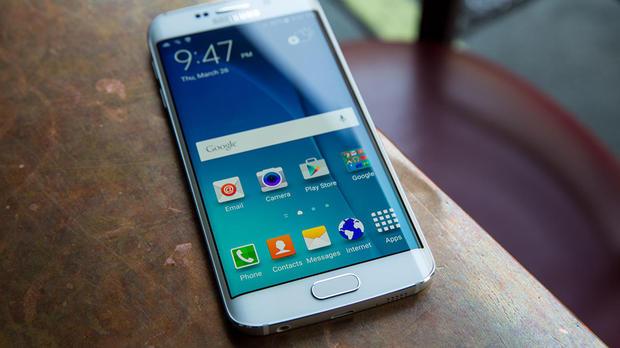 I think of customer loyalty as akin to marriage stability.
I think of customer loyalty as akin to marriage stability.
Many claim it, fewer practice it.
So every time I see numbers attached to consumers’ feelings, I approach them with several Siberian effigies of Lot’s wife, just in case.
However, numbers tossed at me today offer me pause for thought. They suggest that Samsung enjoys markedly more customer loyalty than Apple.
These figures were lobbed over by SurveyMonkey, a company that hired all the primates from the CareerBuilder ads and forced them to perform surveys. (That statement may not be entirely accurate.)
SurveyMonkey likes to define industry benchmarks to help companies and human beings judge where brands stand. Samsung scored a 35 for customer loyalty, while Apple managed a 28. Both scores were above the industry benchmark of 19.
Where Apple did better, however, was in customer service satisfaction. There, it scored a 41 percent positive rating, while Samsung managed only 25. Both companies may still have much to do. The industry benchmark for customer service satisfaction is 75 percent.
Why might both lag? Is it that our phones and laptops are so important to us that they get so much use, thereby offering constant problems which no company could ever truly fix? Is it that while Apple has at least made some headway in providing Geniuses at customers’ disposal, it’s still not easy to talk to one and hear sense?
Or could it be that when people answer surveys their most capricious, malicious side pops out occasionally?
These numbers were generated in the fourth quarter of 2014. They represent more than 5,000 adults in SurveyMonkey’s so-called Audience, which was polled to offer its views on certain brands.
One brand that doesn’t come out of it at all well is Microsoft. For customer loyalty it scored a staggeringly hellish -8. That’s the sort of score you might expect from Comcast and Time Warner. (Well, actually they both managed -50, against an telecoms industry benchmark of -17. Time Warner actually beat Comcast for customer satisfaction. The proof is below.)
Microsoft fared slightly better in customer service satisfaction. It managed a 19 percent score there.
Companies keep their own internal figures and are constantly fretting in a “they-love-me, they-love-me-not” manner.
These numbers may merely hint at how hard it is to please people, as well as how hard it is when you’ve forced people to use your products for far too long and suddenly discover that those people have moved on.
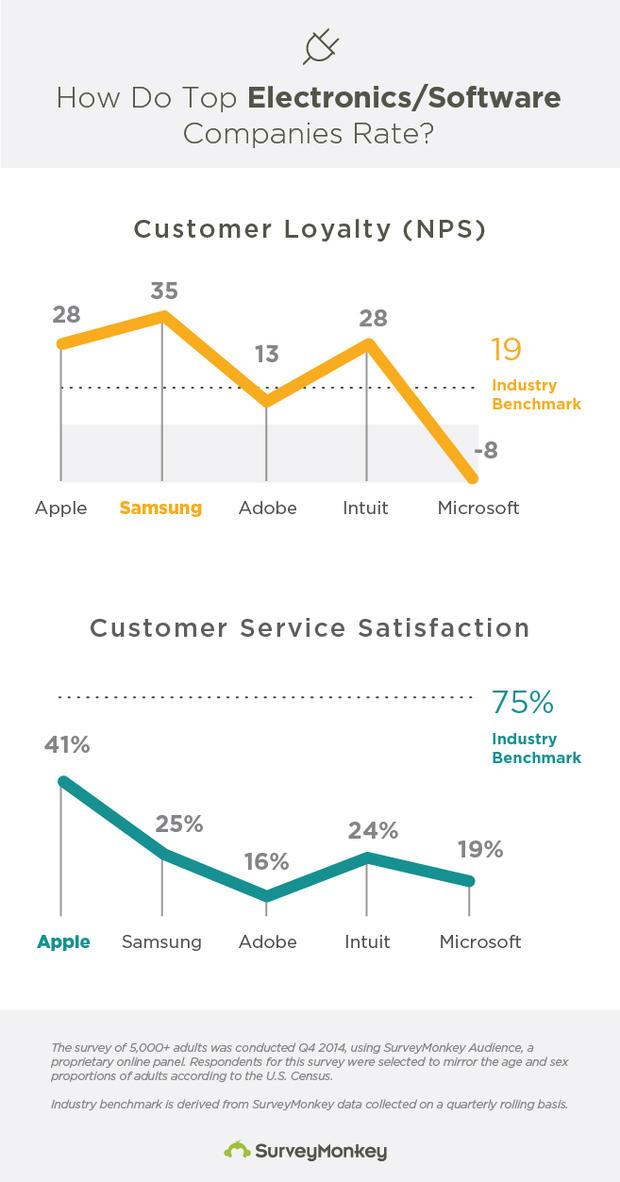
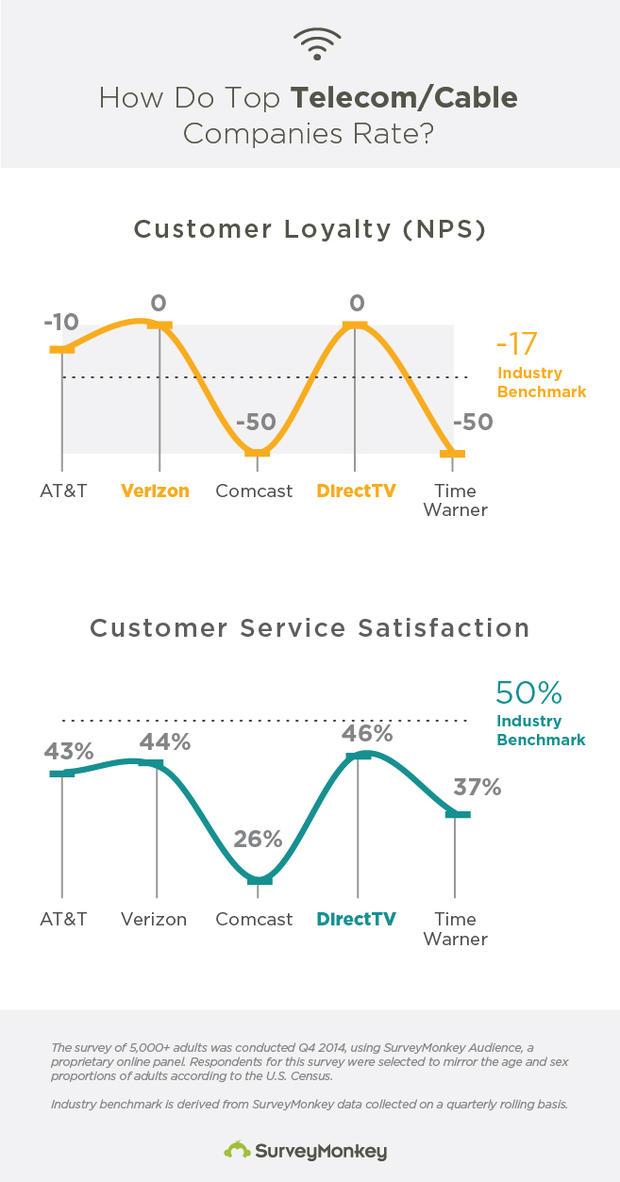
HTC One M9 Review: Déjà Vu All Over Again
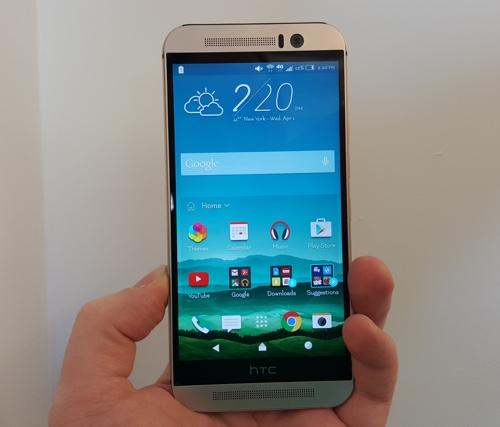
HTC’s new smartphone is here: the One M9. The follow-up to the One M8, one of the best smartphones of 2014, the M9 ($199 with a two-year contract) sports a new camera, faster processor, and a variety of more subtle upgrades.
But the One M9 is battling some stiff competition in Samsung’s excellent Galaxy S6 and Apple’s iPhone 6. So, should you make the One M9 your next smartphone?
Haven’t we met before?
HTC’s motto for the One M9’s design should be, “If it ain’t broke, don’t fix it.” The phone is nearly identical to its predecessor, the excellent One M8, which was nearly identical to 2013’s acclaimed One M7
It’s almost as if HTC took the One M7 and M8 and smashed them together to create the One M9. Like the M7 and M8, the M9 is absolutely gorgeous. The newest phone features the same all-metal body as its forerunners, along with HTC’s wonderful BoomSound dual front speakers.
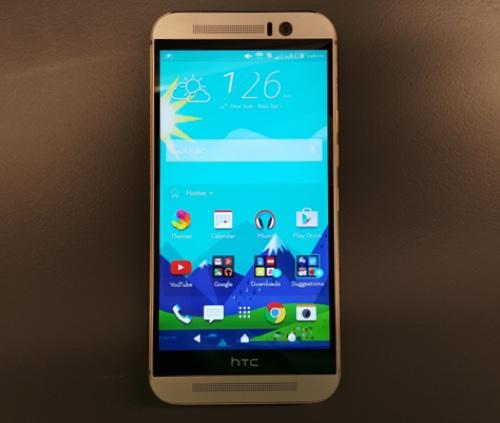
To keep its metal back panel looking polished, HTC has coated it with a scratch-resistant finish that also helps to improve grip. Color options for the M9 include a beautiful two-tone silver and gold and gunmetal gray. Do yourself a favor and get the two-tone model. It just looks classier.
The fact that the M9 looks like the M7 and M8 doesn’t make it any less attractive; all three phones are among the best-looking smartphones you can buy. But, as Yahoo Tech’s Jason Gilbert pointed out in his commentary on the One M9, HTC could have done so much more with the M9’s design, but instead it has left it to stagnate, and that’s a shame.
A beauty of a screen
Like the HTC One M8, the One M9 comes with a 5-inch, 1920 x 1080 resolution display. Why not go with a higher-resolution screen like the 2160 x 1440 resolution panel found on Samsung’s Galaxy S6? Because there’s no reason to.
The average person can’t tell the difference between a screen with a resolution of 1920 x 1080 and one with a resolution of 2160 x 1440, so HTC decided to stick with the lower resolution, as it uses less battery power.
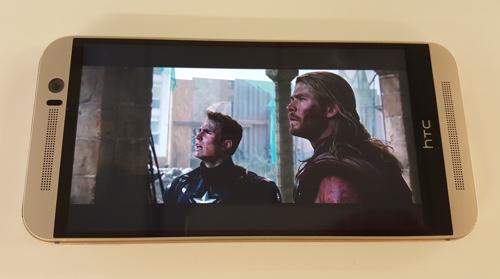
Images and videos on the One M9 look extremely sharp, and easily match those viewed on the S6 and iPhone 6. The biggest differences between One M9 and its competitors are in brightness and color.
Next to the S6 and iPhone 6, the One M9’s display looks relatively dim. Similarly, colors look cooler when viewed on the One M9. Colors appear a bit warmer on iPhone 6’s display, though the Galaxy S6’s screen was easily the most vibrant.
Intense audio
Like its predecessors, the HTC One M7 and One M8, the One M9 packs a pair of front-facing speakers that pump out the best audio quality of any smartphone. The speakers, which HTC calls BoomSound with Dolby Audio, are easily loud and clear enough to rival small standalone Bluetooth speakers.
No, they’re not going to replace your high-end audio setup, but they are more than good enough for small parties, or if you just want to listen to some tunes while doing work around the house.
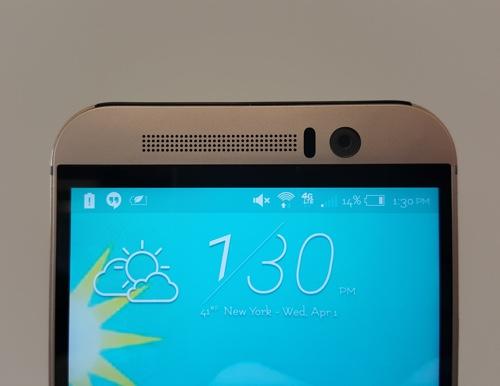
The One M9’s BoomSound speakers come with two audio modes, Theater and Music, which you can adjust on the fly to provide different audio profiles. BoomSound also provides four audio modes for headphones, each of which adjust the sound profile a bit more than the last.
If your biggest concern when you buy a smartphone is how it makes your music sound, then look no farther than the M9.
Camera troubles
In previous years, HTC used gimmicky language and features to push its cameras. The One M7 introduced us to HTC’s “UltraPixel” camera, which used larger pixels, but fewer of them, while the One M8 gave us the company’s Duo Camera, which consisted of an UltraPixel camera and a secondary depth-sensing camera below it.
This time around, though, HTC is ditching the silly names and technologies for a straight-up 20-megapixel rear camera. For all that messing about, the results are largely the same.
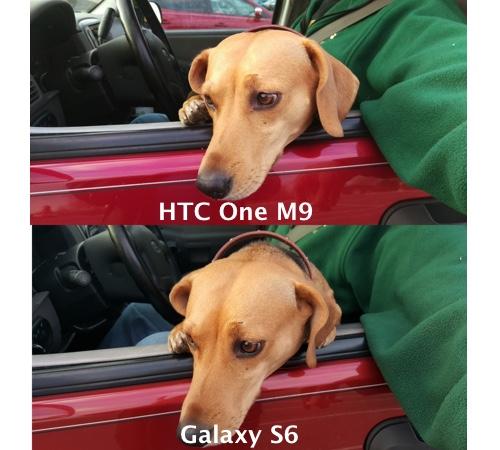
Photos taken in well-lit settings looked clear, though not quite as sharp as those taken with the iPhone 6 or Galaxy S6. Low-light photo performance, on the other hand, was exceedingly poor.
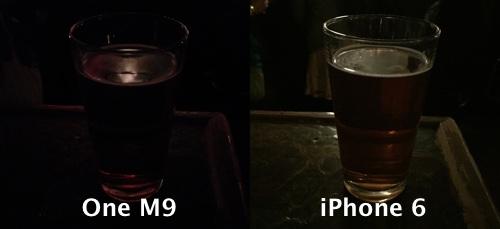
A photo of a beer tap taken with the M9 looked grainy and blown-out, compared to an image of the same scene taken with the iPhone 6. A shot of a beer taken with the M9 was equally murky compared to the iPhone’s image.
HTC did, however, add some interesting camera features, including its Prismatic mode, which lets you add a kaleidoscope-style filter to your photos. Still, HTC should just have worked on overall image quality, which is a major selling point for most smartphone buyers.
A smarter smartphone
HTC’s One M9 runs on Google’s Android Lollipop operating system. And like most Android smartphone makers, HTC adds its own overlay to Android, complete with its own look and feel. HTC’s is called Sense. There isn’t much of a difference between this latest version of Sense and the one found on the HTC One M8, beyond some new themes and color options.
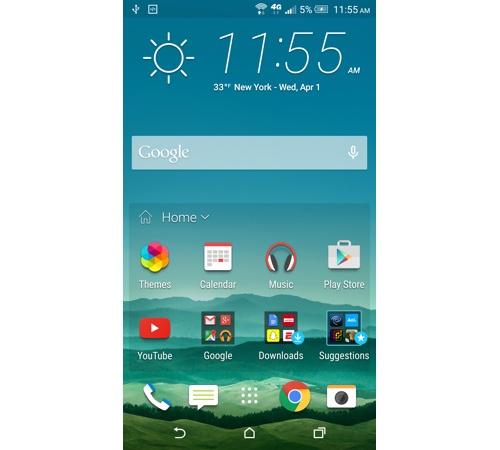
The biggest change to the One M9’s interface is a new app widget (an app that you interact with from your phone’s home screen) called Sense Home. The widget figures out which apps you use the most while at the office, at home, or out around town, and automatically surfaces them based on the time of day and your location.
Say, for example, you use Gmail and Spotify a lot while on the go, and Google Drive in the office. Sense Home will learn your usage patterns, and the next time you walk into your office, it will populate the Sense Home screen with Google Drive and any other apps you use at work.
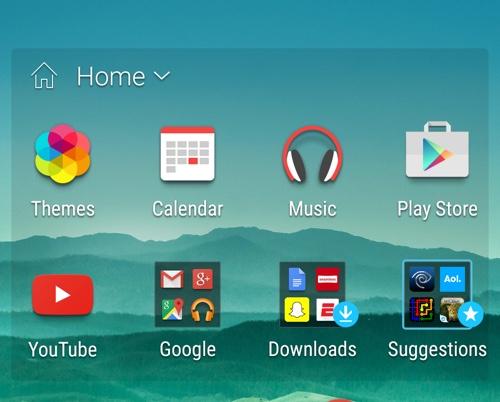
It’s an interesting feature, but the thing that I find most helpful about it is that it automatically saves your downloaded apps to a Download folder, rather than just sticking them wherever there is space on your phone’s home screen.
There’s also a new Themes feature that lets you adjust the look of the One M9’s interface from icon styling to the color of app borders. It’s actually a pretty fun app, and gives your phone a greater sense of character.
A hot performer
In the months leading up to the HTC One M9’s launch, questions persisted about overheating problems associated with the processor included in the M9. And while those issues don’t seem to be as problematic as they sounded before the One M9’s launch, the back of the handset does get rather warm if you are using it for even a moderate amount of time.
In terms of overall use, the One M9 is as speedy as the rest of the current flagship smartphones on the market. You’ll be able to browse the Web, stream music and movies, and play basic games with ease.
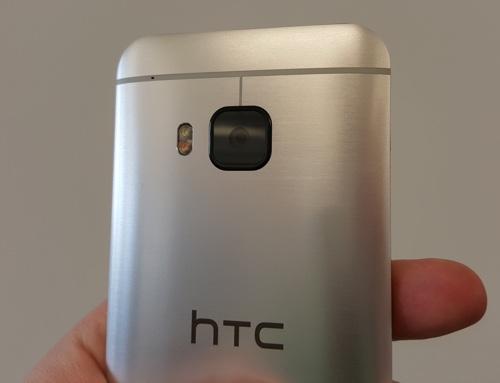
Unlike Samsung, which did away with microSD card slots for its Galaxy S6, HTC still has one, and it has added to its card slot, by increasing its storage capacity to a ridiculous 2TB of memory, in addition to the handset’s initial 32GB of internal storage. That should be plenty of room for your movie and music collections, as well as your photos. Of course, finding a 2TB microSD card will prove difficult, as they don’t exist yet. Yes, the One M9 uses a spec for something that you can’t even buy.
The One M9 packs a relatively large battery, which should get you at least a full day’s use without requiring a recharge. If you start running out of juice, you can always switch on the One M9’s Power Saver or Extreme Power Saver modes, which cut back on the handset’s performance and capabilities in favor of conserving battery life.
UH OH protection
To make the One M9 more intriguing to consumers, HTC is including its free UH OH Protection with every new M9. A built-in safety plan, UH OH Protection promises One M9 customers a free replacement phone if they drop, crack, or otherwise ruin their handset in the 12 months of its release.
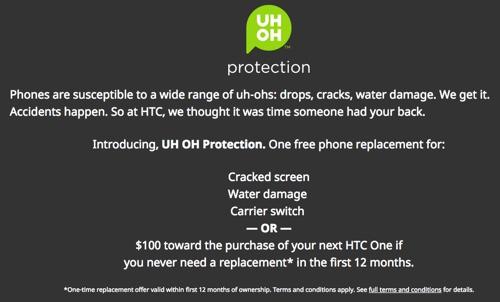
The company will also provide you with a new phone if you decide to switch carriers. If you don’t use your UH OH Protection within the first year, HTC will provide you with up to $100 toward the purchase of a new phone.
A repeat performance
The HTC One M9 is a gorgeous smartphone with powerful speakers and tons of storage. But it’s more of a repeat of the One M8 than a truly new handset. Not only is its design largely unchanged, but its new 20-megapixel camera suffers from the same problems as its predecessor’s UltraPixel camera.
I want to like the One M9, because I was such a big fan of the One M8, but it simply left me wanting more. HTC may have been able to get by on its phones’ looks when Samsung was making handsets that felt like plasticky toys, but now that Samsung’s flagship Galaxy S6 has an equally attractive design, coupled with an excellent camera and a host of other features, the One M9 feels like an also-ran.
Microsoft’s New Surface 3 Hybrid Tablet: It’s a Terrific Value
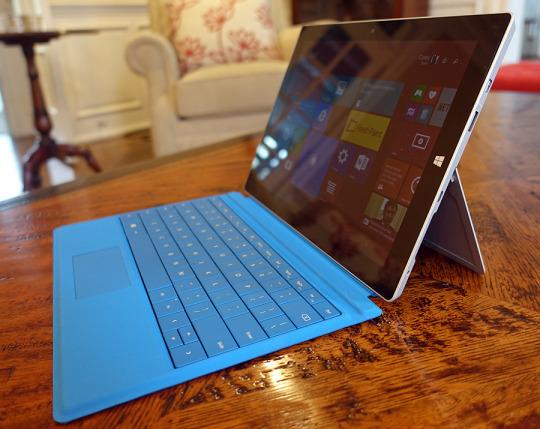
When Apple unveiled the iPad — but before it went on sale — the tech press pretty much pronounced it dead on arrival. “My god, am I underwhelmed,” wrote Gizmodo. “An abysmal failure,” said the Orange County Web Design blog. “Consumers seem genuinely baffled by why they might need it,” pronounced Businessweek. Even our own Rafe Needleman, then at CNET, predicted the failure of tablets in general (he went on to become a tablet junkie).
What they all missed, of course, was a fun fact about human nature: When people are mobile, they don’t care that they don’t have all the horsepower of a PC. They’re content to read, listen, watch, browse. A much-lighter-weight computer is perfectly fine when you’re away from the desk.
But now, as smartphones get bigger and more powerful, tablet sales are slowing. So the computer industry is searching for the next big hit — and it’s keeping the portability lesson in mind. Take, for example, Microsoft’s new Surface 3.
The Surface concept
The idea sounds pretty great. The Surface 3 is a tablet with a hinged panel on the back that flips out to become a kickstand, propping the whole thing up. Throw in the Type Cover — a wafer-thin, felt-lined cover with a full keyboard and trackpad on the inside — and you’ve got yourself a reasonable facsimile of a traditional laptop. With a touchscreen.

Let’s just admit it: It’s really fun to conclude a work session by collapsing the whole thing with one hand into a handy slab to shove into your bag.
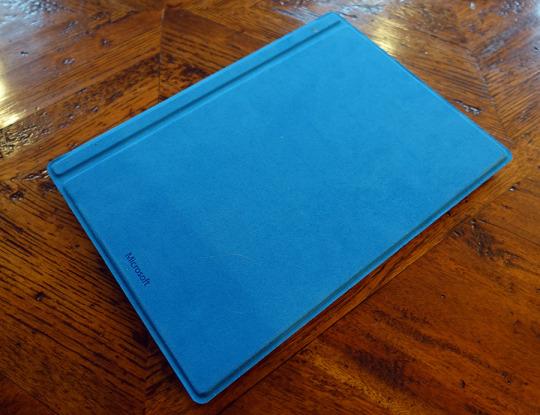
Until now, there have always been two versions of the Surface. There is the Pro version, which runs real Windows: the desktop, the taskbar, and any of the 4 million Windows programs (Quicken, Photoshop, iTunes, and so on).
And there was the original and cheaper model, the Surface RT, which could not run Windows programs — only iPad-like tablet apps, of which there weren’t very many. A middle-schooler could have told you that the RT would flop, and it did.
This week, Microsoft quietly introduced the successor to the RT and the similar Surface 2, simply called the Surface 3. It’s a smaller, lighter, thinner, slower version of the Surface Pro 3, which Microsoft introduced last year — and, with a $500 price tag, much less expensive. (Here’s my review of the Pro 3. Might be worth a skim.)
To keep the price down, Microsoft made a few changes. The screen is 10.8 inches diagonal instead of 12.
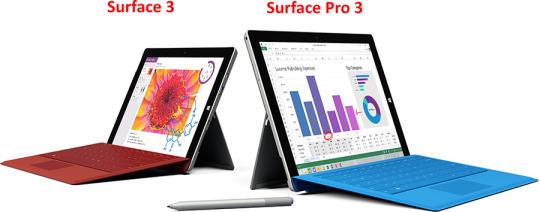
The processor inside is the new Intel Atom x7, which isn’t as fast as the i3, i5, or i7 chip inside the Pro or almost any other laptop. The primary penalty you’ll pay is the time it takes to open programs. It takes a long time: with some, 10 seconds or more.
Once you’re in them, though, you don’t notice much speed difference. Word, PowerPoint, Excel, Netflix, OneNote, Maps, Skype — all of them run smoothly. Just don’t think you’re going to be doing much gaming and 3D modeling on this puppy.
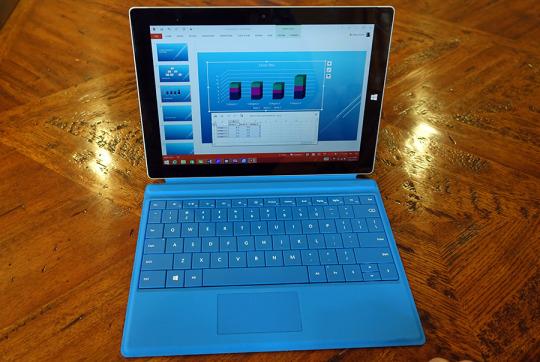
Sadly, the Surface’s power brick no longer harbors a second USB jack for charging your phone or something else, as the Pro’s does. And the new Surface’s kickstand snaps to your choice of three angles, rather than being infinitely adjustable.
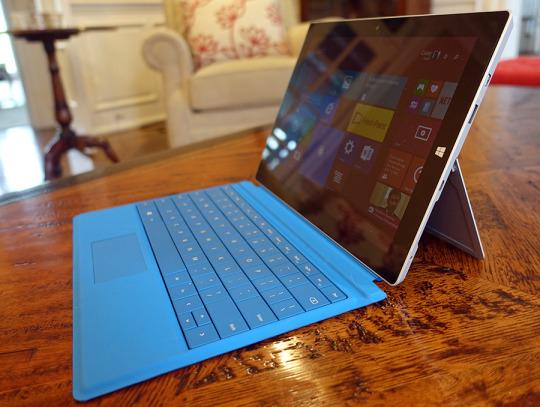
On the other hand, in some ways, the new Surface is better than the Pro. For one thing, the 1.8-pound Pro can be unwieldy to hold in one hand for a long time. At 1.4 pounds, the new model is much more handy.
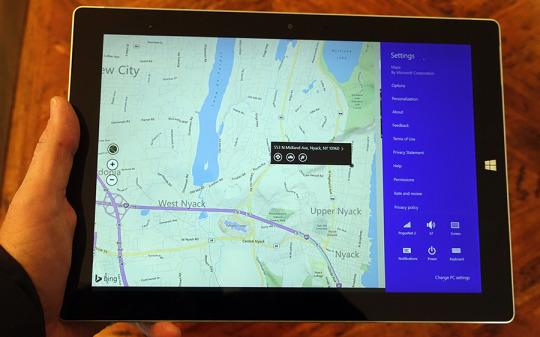
You could argue that the cameras are better, too — 8 megapixels on the back with autofocus, 3.5 megapixels on the front (the Pro has the same 5-megapixel camera on the front and back).
The Surface gets 10-hour battery life instead of 9. And its power cord connects with a micro USB jack, the same one that charges up non-Apple phones and tablets. That means you can now use the same charging cord for your “laptop” and your other devices. You could make the Surface a parasite and charge it from the USB jack of another computer, if you wanted to, although it charges much faster from a wall outlet.
(Online wags have already discovered, with some amusement, that you can actually charge the Surface from itself, by plugging one end of the power cord into the Surface’s own USB jack. Something tells me that despite the “charging” indicator that appears, you’re not actually defying the laws of chemistry and physics.)
You can also buy this Surface model with a cellular modem, so that you can get online anywhere — a truly wonderful option, and one that’s not available on the Pro or on any Apple laptop (although you can get it on iPads). That feature adds $100 to the price, and of course you’ll have to pay for your data. (So far, Verizon and T-Mobile have signed on to offer the Surface; other carriers may be coming.)
And as a further gesture of goodwill to the Surface’s target market — students, families, corporate minions — Microsoft throws in a year of Office 365 Personal, which gives you 1 terabyte of storage online and access to the full Word, Excel, PowerPoint, and Outlook programs.
The Surface and Surface Pro models both include a full-sized USB jack, a Mini DisplayPort jack for connecting a monitor or projector, and a MicroSD memory-card reader. Into that slot you can insert memory cards up to 128 gigabytes, which can act as an “external hard drive” for more space. (The Surface comes with 64 or 128 gigabytes of built-in storage, in the $500 and $600 models, respectively.)
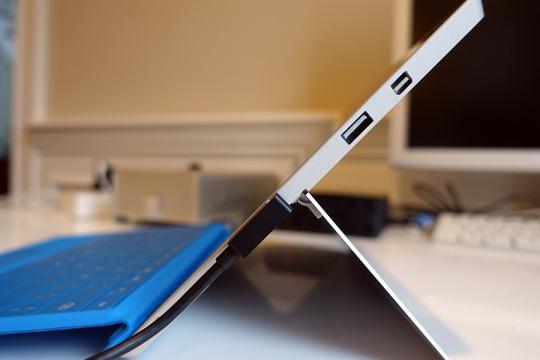
The extras
That Type Cover thing is pretty much a must-have; without it, you’re missing most of the magic of the Surface concept. It’s $130.
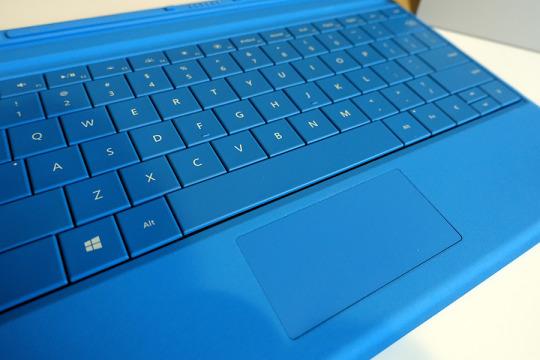
The typing feel itself is excellent — the keys have nice, clicky travel — but the keys are smaller than normal, and the trackpad response is iffier than on a real laptop. That doesn’t seem to stop Surface fans from merrily typing away — I’ve started seeing Surfaces on airplane tray tables — but you’ve been warned.
The $50 Surface Pen is also worth considering. It’s a pressure-sensitive stylus that lets you draw or write on the touchscreen, even if you’re resting your palm on the glass. If you click the pen’s top button, you wake a sleeping Surface directly to a blank OneNote note-taking document. That’s handy when you want to jot something down in a hurry, like a song lyric or product sketch that’s just occurred to you.
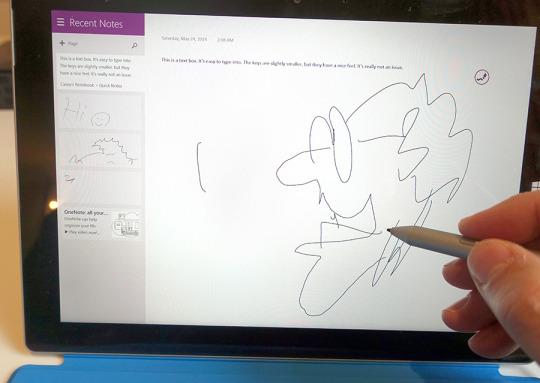

Finally, $200 can buy you a desktop docking station. When you’re done being mobile, you can snap the Surface into this dock, which you leave connected to mouse, keyboard, hard drives, big screen, and so on. (It has four USB jacks — two USB 3.0 and two USB 2.0 — plus an Ethernet jack, video output, an audio in/out jack, and a security lock slot.) It’s black plastic, and the docking itself is a fussy manual process, but it does the job.
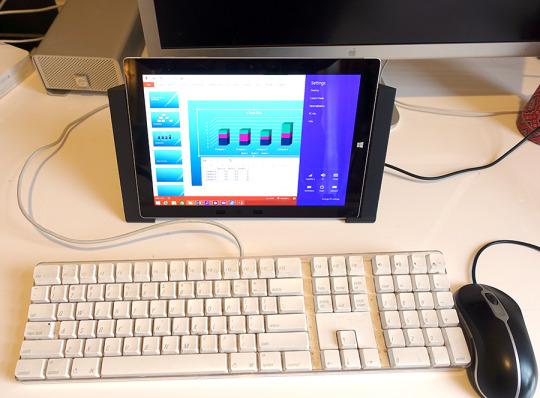
Under the Surface
The Surface isn’t for everyone. If you don’t think you’ll be using it as a tablet, you’ll get more storage and power for the money by buying a straight-up touchscreen laptop.
But the value of this machine is eye-popping, especially when you compare it with the iPad. The $500 you pay to Microsoft gets you a 64-gigabyte tablet with a USB port and memory-expansion slot; the same money paid to Apple gets you a 16-gigabyte tablet with no ports or slots. The Surface can run any of 4 million Windows programs (and, by the way, also the Chrome OS and Chrome apps); the iPad can run 725,000 iPad-optimized apps, plus about a million enlarged phone apps.
There are footnotes to that analysis, of course. An iPad makes you part of Apple’s rather spectacular ecosystem of products and services, weighs 30 percent less than the Surface, and never needs antivirus software. And the iPad’s software is infinitely less complicated than Windows — especially the Franken-OS that is Windows 8.1. Fortunately, if you buy a Surface, you’ll be able to upgrade to the much better Windows 10 this summer, no charge.
But think about it: They’ve managed to pack a full-blown Windows PC into a tablet. If we’d seen this 10 years ago, we would have fallen down and worshiped it as a god.
Microsoft’s hardware divisions have been firing on all cylinders lately. The non-Pro Surface is another winner and deserves to become a hit.
Subscribe to:
Comments
(
Atom
)